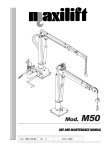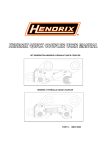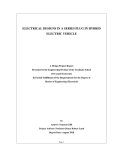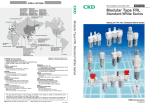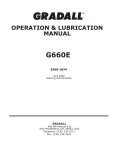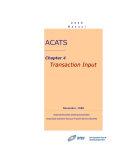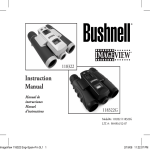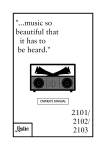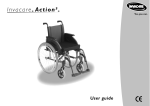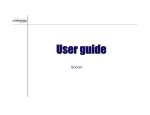Download OPERATOR`S MANUAL G3WD - Gradall Hydraulic Excavators Service
Transcript
OPERATOR’S MANUAL G3WD 7733-1006 July 2002 Upperstructure Starting S/N 8731229 Undercarriage S/N Starting 87D024 Also Covers Upperstructure NP-411894 Undercarriage 86D104 Form #8606 Original Issue 1986 GRADALL 406 Mill Avenue S.W. New Philadelphia, OH, 44663, USA Telephone: (330) 339-2211 Fax: (330) 339-3579 IMPORTANT SAFETY NOTICE Safe operation depends on reliable equipment and proper operating procedures. Performing the checks and services described in this manual will help to keep your Gradall Excavator in reliable condition and use of the recommended operating procedures can help you avoid accidents. Because some procedures may be new to even the experienced operator we recommend that this manual be read, understood and followed by all who operate the unit. Danger, Warning and Caution notes in this manual will help you avoid injury and damage to the equipment. These notes are not intended to cover all eventualities; it would be impossible to anticipate and evaluate all possible applications and methods of operation for this equipment. Any procedure not specifically recommended by The Gradall Company must be thoroughly evaluated from the standpoint of safety before it is placed in practice. If you aren’t sure, contact your Gradall Distributor before operating. Do not modify this machine without written permission from The Gradall Company. NYLON BRAKE LINES MAY BE DAMAGED BY HEAT. AVOID WELDING ON OR AROUND THE MACHINE UNLESS BRAKE LINES ARE PROTECTED FROM HEAT. DISCONNECT BATTERY BEFORE WELDING ON MACHINE. NOTICE The Gradall Company retains all proprietary rights to the information contained in this manual. The Company also reserves the right to change specifications without notice. Gradall is a registered,trademark for hydraulic excavators, hydraulic material handlers and attachments manufactured by The Gradall Company. The Gradall Company 406 Mill Avenue, S.W. New Philadelphia, Ohio 44663 INTRODUCTION General P I N Location (Product Identification No.) This manual provides important information to familiarize you with safe operating procedures for the Gradall Hydraulic Excavator. Specify PIN and lot number when ordering parts and when discussing specific applications and procedures with your dealer. The PIN plate is located on front center portion of upperstructure frame. Throughout this manual, the term “carrier” will be used to designate the excavator undercarriage. Related Manuals Separate publications are furnished with the Gradall to provide information concerning safety, replacement parts, service manual with vendor components and literature. You must read and understand the Gradall Operation Manual and Safety Manuals before operating the machine. If you have any questions regarding the Gradall Excavator, contact your Gradall Distributor; he is thoroughly familiar with the unit and will be happy to help you. Serial Number Location Operator Qualifications The operator must hold a valid, applicable driver’s license which requires acceptable age, vision, hearing, manual dexterity and response. He must also be in acceptable physical and mental condition (not undergoing medical treatment or using drugs or alcohol which would violate traffic laws.) The carrier nameplate is located on the right side. Be sure to specify the serial number (on nameplate) when ordering parts and when discussing procedures and applications with your distributor. Before driving the unit on the highway or operating the excavator at a worksite, the operator must familiarize himself with the machine by practicing in a safe, open area not hazardous to people or property. Orientation When used to describe locations of components in the upperstructure, the directions front, rear, right and left relate to the orientation of a man sitting in the operator’s seat. In relation to the carrier, front, rear, right and left are determined by the orientation of a man sitting in the driver’s seat. 2 SAFETY HIGHLIGHTS Read and understand this manual, The Gradall Excavator Safety Manual, CIMA Safety Manuals and all instructional decals and plates before starting, operating or performing maintenance procedures on this equipment. KEEP THIS MANUAL IN THE CAB. Watch for these symbols; they are used to call your attention to safety notices. DANGER This symbol indicates an extreme hazard which would result in high probability of death or serious injury if proper precautions are not taken. WARNING This symbol indicates a hazard which could result in death or serious injury if proper precautions are not taken. CAUTION This symbol indicates a hazard which could result in injury or damage to equipment or property if proper precautions are not taken. WARNING Perform all “CHECKS & SERVICES BEFORE STARTING ENGINE” and all “WARM-UP & OPERATIONAL CHECKS” at the beginning of your shift. Complete all required maintenance before operating or driving the unit. Maintain three point contact with grab handles and steps when climbing on and off the machine. Never jump from the machine. Repair or replace damaged steps and grab handles. 3 CARRIER CAB CONTROLS INSTRUMENTS AND INDICATORS While in lower cab, the four wheel drive can be engaged at any time in the lower range. Use low R.P.M. Do not move carrier while low air light is glowing or while any auxiliary device is signaling a dangerous condition. 17. Fuel Gage 18. Front Axle Disconnect (4x4 only) 19. Ignition Key Switch 20. Parking Brake Button 21. Remote/Travel Switch 22. Dome Light 23. Windshield Wiper Speed Control 24. Windshield Washer Switch 25. Headlights Hi/Low Beam Switch 26. Brake Pedal 27. Acclerator Pedal 28. Emergency Engine Shut Off 29. Transmission Control Monitor 30. Turn Signal Control Lever 31. Hazard Flahser Switch 32. Horn Button 1. Heater Control Knob 2. Defroster Switch 3. Heater Switch 4. Headlights Switch 5. Pump Engagement Light 6. Converter Oil Pressure Gage 7. Display Light Panel 8. Air Pressure Gage 9. Water Temperature Gage 10. Transmission Shifter 11. Volt Meter 12. Oil Pressure Gage 13. Tachometer 14. Speedometer 15. Hour Meter 16. Converter Oil Temperature Gage 4 UPPERSTRUCTURE CAB CONTROLS AND INSTRUMENTS 10. Engine Start Switch 11. Defroster Switch 12. Warning Buzz Light 13. Emergency Brake Knob 14. Air Pressure Gage 15. Forward/Reverse Travel Pedal 16. Steering Pedal 17. *Heater *Optional 1. Throttle Lever 2. Boom In/Out & Swing Joystick 3. Boom Tilt Switch 4. Transmission Shift Up/Down Switch 5. Horn Switch 6. Boom Hoist & Bucket Joystick 7. Joystick On/Off Switch 8. Engine Stop Switch 9. * Windshield Wiper/Washer Switch While working in upper cab, and any of the display panel warning lights go on in the carrier cab, a buzzer will sound in both cabs. The operator should place boom in rack, shut engine off and go to lower cab and check all gauges and determine reason for warning. Correct malfunction before continuing to operate. 5 CARRIER CAB DISPLAY LIGHT PANEL Left turn signal (A) flashes when lever on steering post is activated to indicate a left hand turn. (GREEN) If air pressure drops below 60 psi, (F) will light. (RED). Check gauge. If engine temperature reaches 210° F, (G) will light. (RED). Check gauge. Remote Control Indicator (B) is lit when the remote rocker switch is depressed and all of the pre-conditions are met. It will turn RED. At this time the remote drive motor should be engaged and the digging brakes applied and upper throttle engaged. If engine oil pressure drops to approximately 15 psi, (H) will light. (RED). Check gauge. If battery is below 12 volts, (J) will light. (RED) Right turn signal (K) flashes when the lever on the steering post is activated to indicate a right hand turn. (GREEN) If torque converter temperature reaches 250° F, (C) will light. (RED) If torque converter pressure drops below 200 psi, (D) will light. (RED) If head light switch is pulled and the foot button is depressed, the high beam (E) will light. (BLUE) NOTE: If any of the warning lights C, D, F, G or H are on, a warning light and buzzer in the upper cab will be activated. CARRIER CAB CONTROLLER MONITOR The Monitor is located to the right of the drivers seat in the carrier cab. The Controller Monitor provides range selection of the solenoid controlled transmission in both travel and remote modes. It also determines if remote or travel mode has been S1 S2 S3 S4 C1 S5 S6 C2 selected by the operator and controls the machine changeover to the mode selected. The Controller Monitor has a panel of 14 lights which shows the driver the status of the control system. Transmission Solenoid #1 energized when lit. Transmission Solenoid #2 energized when lit. Transmission Solenoid #3 energized when lit. Transmission Solenoid #4 energized when lit. Solenoid Air Valve shifted to travel mode when lit. Transmission Solenoid #5 energized when lit. Transmission Solenoid #6 energized when lit. Solenoid Air Valve shifted to remote mode when lit. Neutral Reverse T1 T2 T4 Neutral Start Solenoid closed when lit. Travel alarms and back-up lights energized when lit. Low air condition exists when lit. Engine not running when lit. Hyd. Pump and Remote Motor engaged when lit. Malfunction Indicator Indicates a wire shorting between the Controller Monitor and the transmission shift solenoids. (Wires S1 through S6) 6 SHIFT SOLENOIDS. A combination of these lights tell which gear ratio has been selected. The position of the gear selector lever on the dash should match. The following will show the light combinations while in the travel mode with high air and the key turned on and engine running: C1 is lit to show the travel mode. S1 C1 S6 - First Travel Gear S1 C1 S5 - Second Travel Gear S2 C1 S6 - Third Travel Gear S2 C1 S5 - Fourth Travel Gear S3 C1 S6 - Fifth Travel Gear S3 C1 S5 - Sixth Travel Gear 7 C2-T4. The following lights are lit when the remote control switch is depressed to show the gear ratio being used: The shift lever in the carrier cab will not move. With engine running, and in remote, lights C-2, T4 and Neut Start will be lit. C2 is always lit. . S1 C2 C3 & T4 - First Remote Gear S2 C2 C3 & T4 - Second Remote Gear S3 C2 C3 & T4 - Third Remote Gear 8 NEUTRAL. Any time the shift lever in the carrier cab is in the neutral position, the Neutral light will be lit. The travel shifter must be in neutral before engine can be started, or switched from Travel to Remote and vice versa. If in Travel, the C1 light will also be lit. If in Remote, the C2 Remote and the T4 Remote mode lights will be lit. REVERSE. The following show the lights which are lit when in the 3 reverse positions. Reverse C4 is lit to show it being in the reverse mode. The Reverse C4 light and the C1 light will always Be lit. CI indicates travel mode. S1 S4 C1 & C4 - First Reverse Gear S2 S4 C1 & C4 - Second Reverse Gear S3 S4 C1 & C4 - Third Reverse Gear 9 MALFUNCTION INDICATOR. Indicates a wire shorting between the Controller Monitor and the transmission shift solenoids. It can also indicate that the Controller Box is defective and should be replaced. LOW AIR. If the system air pressure drops below 60 psi, T1 will light. ENGINE OFF. Any time the engine is running, no light will show at the T2 position. If the engine stops, T2 position will be lit. PUMP ENGAGED. When the remote switch is depressed, the air circuit shifts cylinders to engage the hydraulic pump and the remote drive motor. If the pump is engaged fully, the T4 light will be on. 10 CHECKS AND SERVICE BEFORE STARTING ENGINE (To be performed at beginning of each work shift) Complete all required maintenance before operating unit. 1. 2. 3. 4. 5. 6. 7. 8. 9. 10. 11. 12. Inspect visually for damage, leaks, vandalism & needed maintenance. Test lights, turn signals, horn, & gages. Inspect battery fluid level. Make sure fire extinguisher is present. Inspect level of windshield washer fluid. Make sure remote switch is in travel position. Check coolant level. Check engine oil level. Check fuel level. Check for clean windows. Check hydraulic oil level. Lubricate as shown in manual. Starting Diesel Engine from Carrier Cab 1. Be sure main transmission is in neutral, parking brake is applied and engine stop handle is fully depressed. 5. Warm up diesel engines at approximately one third of governed speed until water temperature reaches operating range (approximately 160°F./71°C). 2. Depress accelator pedal to a fast idle and hold in this position. NOTE: It may be necessary to use a cold weather starting aid in temperatures below freezing. 3. Turn ignition switch fully clockwise to engage starting motor. Release key immediately when engine starts. If engine fails to start within fifteen seconds, release key and allow starting motor to cool for a few minutes before trying again. Do not engage starting motor while flywheel or starting motor is rotating. Serious damage could result. 4. After engine starts, observe oil pressure gage. If gage remains on zero for more than ten seconds, stop engine and determine cause. Correct before restarting engine. Stopping the Engine from Carrier Cab Operate engine at idle speed for a few minutes before turning it off. This allows engine coolant and lubricating oil to carry excessive heat away from critical engine areas. Do not “gun” engine before shut down; this practice causes raw fuel to remove oil film from cylinder walls and dilute lubricant in crankcase. To stop diesel engine, turn key to off. 11 Cold weather starting aids Start in travel mode (pump not operating). Diesel engine ignition is accomplished by heat generated when fuel/air mixture is compressed within the cylinders. Because this heat may be insufficient to start a cold engine in cold weather, the use of starting aids has become common practice. it would be impractical to attempt to provide specific instructions for their use in this manual. Carefully follow instructions furnished with your starting aid. If you use a starting aid employing ether or a similar substance pay particular attention to manufacturer’s warnings. Because of the wide variety of starting aids available Normal engine operation When using engine braking power (downshifting or releasing accelerator and permitting carrier to “push” engine) to slow travel, take care to avoid overspeeding the engine (exceeding governed RPM). The governor has no control over engine speed when engine is being “pushed” by carrier load. Observe voltmeter, water temperature and oil pressure gages frequently to be sure all engine systems are functioning properly. Be alert for unusual noises or vibration. When an unusual condition is noticed, stop in a safe area and shut off engine. Determine cause and correct before continuing. Select an appropriate gear ratio and use service brake to assist in slowing travel down steep grades. Early recognition and correction of unusual conditions can often prevent a major breakdown. Apply load to engine gradually; shock loads are hard on all drive line components. Permitting the engine to labor under too great a load for the gear ratio being used (lugging the engine) will shorten engine life. Shift to the proper gear ratio for conditions. Use full governed engine speed for intermittent duty only. For cruising or continuous duty use approximately 85 percent of full governed engine speed to maintain safe speed. This practice provides increased engine life. Avoid prolonged idling. Idling causes engine temperature to drop and this permits formation of heavy carbon deposits and dilution of lubricating oil by incompletely burned fuel. If the engine is not being used, turn it off. 12 CHECKS AFTER STARTING ENGINE (To be performed at beginning of each work shift) Complete all required maintenance before driving 6. Observe water temperature gage. Proper operating temperature is approximately 160/ 210° F. (71/104° C). 1. Check operation of windshield washer and wiper. 2. Check all lights and turn signals for proper operation. 7. Observe tachometer response to changes in engine speed. 3. Check operation of heater and defroster. 8. Observe low air warning light. Light should continue to glow until brake system pressure reaches approximately 60 psi. Do not release parking brake or move carrier while low air warning light is still glowing. 4. Observe oil pressure gage with engine running at operating temperature and speed. 5. Observe voltmeter indication of alternator output. Proper output is approximately 14 V. with engine running at 2000 RPM. 9. Observe air pressure gages. Proper brake . system pressure is 60/125 psi. CHECKS BEFORE DRIVING (To be performed at beginning of each work shift) Complete all required maintenance before driving. 2. Check operation of steering while moving slowly in first gear. Be alert for any increase in effort needed to turn wheels and any unusual steering response to normal steering effort. 1. Check operation of brakes by performing the following procedure: a. Position unit on level surface and apply digging brake. b. Position boom over rear of chassis and imbed bucket in ground or against a solid object. c. Apply down pressure with boom and pull and push with boom while helper watches for rotation of each wheel. d. Rotation of any wheel during step c. indicates brake failure on that wheel. Have any failure corrected before driving the unit. 3. Check operation of horn and travel and back-up alarm and any other signal devices. PLAN YOUR TRIP 1. Plan a safe route to your destination. 2. Ask your supervisor about permit requirements. 3. Check on load & clearance limits along your route. Dimensions for your unit are shown below: Height - varies depending on attachment — measure unit to be sure. Width (4 x 2). . . . 8'(2.44 m). . . . . . . . . . . . . . . . . . . . 100" on 4 x 4 Ground Clearance . . . . . . . . . . . . . . . . . . . . . . . . . . . . 10" (254 mm) Weight - varies depending on options— weigh unit to be sure. 13 AIR CONTROLS Air pressure is used to control the engine RPM while driving the chassis or while operating the upperstructure. shifts the cylinders at the pump and motor to cause the jaw clutches to close and engage the pump and motor. To keep the pump and remote drive motor disengaged while driving the carrier, air cylinders are used to actuate jaw type clutches. When the remote toggle switch button on the dash is depressed, air A limit switch is placed by the pump engage cylinder to provide a visual warning light if the desired stroke is not obtained and the pump does not fully engage for upperstructure operation. 14 AIR THROTTLE CONTROL CIRCUIT It is possible to control the engine RPM from the carrier cab or the upperstructure cab. Conventional Driving Mode: Remote Control Driving Mode: When driving the carrier, the floorboard accelerator is used to control the engine speeds from idle to top governed RPM. The low idle is about 600 RPM and the top is about 3l50 RPM (No Load) or 2800 RPM (Loaded). When driving the carrier from the upperstructure in the remote control mode a hand controlled air valve is used (8). It is located on the cab floor to the left of the operator’s seat. While in remote a low idle of 600 RPM and a high idle of 2700 RPM (No Load) or 2300 RPM (Loaded) can be obtained. When starting the engine with low air, the spring on the fast idle cylinder (1) works on the governor linkage to obtain a higher than idle speed to help build up air pressure quickly. When the system builds up to 55 psi, the piston in the fast idle cylinder moves to counter the spring tension and the engine will run at normal low idle speed. The remote air circuit is activated when the remote control switch (9) is depressed. Electrical current activates the Air Control Solenoid (10), routing tank air over to the control port of the Air Pilot Valve (4). Air pressure causes the Air Pilot Valve (4) to shift, routing air to the upperstructure circuits thru centerpin (11) and the Hand Throttle Valve (8). When the hand throttle is moved, controlled air is routed back down thru the centerpin (11) and thru the Shuttle Valve (5) to the Throttle Cylinder (6). Normal depressing of the Accelerator Pedal (2) routes air from the tank (3), thru the Air Pilot Valve (4), thru a Shuttle Valve (5), to the Throttle Cylinder (6). Movement of the piston in the throttle cylinder moves the Fast Idle Cylinder and the linkage to the engine governor (7). RPM is determined by the amount of travel caused by pushing down on the treadle valve pedal. 15 HYDRAULIC PUMP & MOTOR DISCONNECT When driving the Gradall from the carrier cab, the hydraulic pump and the hydraulic remote drive motor is not engaged to the transmission. REMOTE OPERATION: When the remote switch (5) is activated the air solenoid (6) routes pilot air to the air pilot valve (2). The plunger shifts and routes air to the opposite ends of the pump and motor cylinders (3 & 4). NORMAL DRIVING: When driving the chassis, air from the tank (1) is routed thru the air pilot valve (2) directly to the two cylinders for the pump and motor (3 & 4) to keep them disengaged. JAW TYPE CLUTCH: Each of the two cylinders are connected to linkage which activates the jaw type clutch (7). The illustration shows the jaws separated. Movement of the linkage which connects to the cylinder rod causes the sliding half to move over and engage the two halves. BOTH DISENGAGED 16 BRAKE SYSTEM The air brake system includes a service brake, an emergency brake, a parking brake and a digging brake. Wear safety belt to avoid being thrown from carrier driver’s seat during braking emergency. WARNING Service brake Do not operate carrier while low air indicator is glowing. If light comes on while carrier is moving, stop carrier in a safe area as soon as possible. If carrier will not maintain proper brake pressure notify maintenance personnel immediately for repair of condition. SERVICE BRAKE APPLICATION Emergency brake The emergency brake functions only when air pressure has been lost from some portion of the dual brake system. Emergency brakes are applied by normal foot pressure on the brake treadle. The basic system includes two reservoirs to store and furnish air pressure for service brake operation. One reservoir supplies pressure to apply brakes to the wheels of the front axle and the other supplies pressure to apply brakes to the wheels of the rear axle. Depressing the brake treadle causes air pressure to be applied to brake actuators of all wheels simultaneously. Emergency brakes will not stop carrier in as short a distance as the service brakes. EMERGENCY BRAKE APPLICATION (pressure lost in front) Do not “fan” the brake valve treadle. A long series of rapid brake applications can reduce system pressure to a point where effective service braking will be lost until air compressor can restore pressure. Operating pressure range for service brakes is 60 to 125 psi. A dual pressure gage is furnished to indicate pressure in front and rear portions of brake system. The red needle shows pressure available for rear axle brakes and the green needle shows pressure available for front axle brakes. If pressure in either portion of the system falls below safe operating range, the low air indicator light will glow. wheels of the front axle. If air pressure is lost from the front portion of the dual brake system, normal actuation of the brake treadle valve will apply service brakes to the wheels of the rear axle. There will be no braking on the 17 BRAKE SYSTEM (Con’t.) If the air pressure gages indicate some system pressure remaining, it may be possible to drive the unit a short distance to remove it from a hazardous position (use first gear only). EMERGENCY BRAKE APPLICATION (pressure lost in rear) If carrier cannot be moved, direct traffic around carrier until warning flags, flares or lights can be displayed. Notify proper authorities and maintenance personnel as soon as possible. Parking brake Apply parking brake by raising parking brake control knob. This causes air pressure to be vented from spring chambers allowing springs to apply brakes to wheels of the rear axle. Knob will raise automatically if air pressure is lost from front and rear portions of system. If the air pressure is lost from the rear portion of the dual brake system, normal actuation of the brake treadle will apply service brakes to the wheels of the front axle and cause a controlled application of spring brakes to the wheels of the rear axle. PARKING BRAKE APPLICATION After pressure is lost from one portion of the dual brake system, there may only be enough pressure in the other portion for one or two emergency brake applications. When the available pressure has been used the spring brakes will apply automatically. EMERGENCY BRAKE APPLICATION (pressure lost in front and rear) Release parking brake by depressing parking brake control knob (system must be pressurized to release parking brake). AUTOMATIC Digging brake In the event air pressure is lost from both front and rear portions of the system there will be an automatic application of the spring brakes. They will begin to apply as pressure drops to 60 p.s.i. (414 kPa) and there will be a complete application when pressure decreases to 40 p.s.i. (276 kPa). When activated, the digging brake is applied to all wheels to hold the carrier stationary while the excavator is digging. Air pressure requirements for digging brake application are not the same as those for the service brake (60 to 85 p.s.i. - 414 to 586 kPa). If pressure is lost after the digging brake has been applied, emergency brakes will be applied automatically. Because air pressure is required to release spring brakes, an automatic application will remain ON until air pressure can be restored. 18 Digging brake (Con’t.) Remote control braking DIGGING BRAKE APPLICATION The digging brake is applied by the remote switch in the carrier cab. The digging brake will be released and reapplied automatically as travel pedal in upperstructure is actuated and released. Do not activate remote switch while traveling. See page 23 for preparing carrier for remote operation. An emergency brake control is located in the upperstructure cab. This control is to be used in case of failure of the automatic digging brake. If digging brake fails to apply when travel pedal is released, raise emergency brake control to apply emergency brake. Notify maintenance personnel immediately for repair of digging brakes. Apply upperstructure emergency brake when leaving upperstructure cab. . As the remote switch is depressed, the digging brakes are automatically applied. Anytime the remote signal light is lit, the brakes are applied, unless traveling in remote. 19 STEERING SYSTEM Conventional steering Remote control steering The power steering system provides low effort steering under normal conditions and greater control in the event of a blowout or soft ground. “Road feel” is similar to that of a conventional manual steering system. Your unit is equipped with a travel/steering pedal in the upperstructure cab. The engine must be running to provide power for remote control steering. Regardless of upperstructure position on carrier, depressing left side of pedal turns wheels to left; depressing right side of pedal turns wheels to right. Use of power steering while carrier is stopped causes unnecessary stress on system components and can cause serious damage to system. When not held in a left or right steering position, the steering pedal will return automatically to its neutral (non-steering) position. Be sure upperstructure cab is kept free of equipment and foreign material which could jam steering pedal in a steering position. Holding steering wheel in full left turn or full right turn position will cause system to overheat. This can cause steering pump to fail. Rotation of the carrier steering wheel will occur during remote operation. KEEP CLEAR! Be alert for any increase in effort needed to steer. If any difference is noted, notify maintenance personnel immediately for correction. If power assist feature should fail for any reason IT WOULD BECOME VERY DIFFICULT TO STEER. For this reason it is extremely important that you NEVER TURN ENGINE OFF WHILE TRAVELING. In the event power steering fails, stop as soon as possible. Do not drive unit until problem has been corrected. 20 POWER TRAIN The power train furnished on 4 x 2 carriers (units having one driving axle at rear) include the engine, torque converter, power shift transmission and the rear axle. It includes the drive shaft between the transmission and the rear axle. The power train furnished on 4 x 4 carriers (units having both front and rear driving axles) include the engine, torque converter, power shift transmission and the front and rear driving axles. The transmission is moved back to the center portion of the frame and drive shafts are used to connect it with the engine and the two axles. Torque Converter Torque converter oil temperature and oil pressure gages are provided to monitor torque converter operation. There are no operator controls for the torque converter. It functions automatically to permit starting from a standstill in any transmission speed range. POWER SHIFT TRANSMISSION The power from the engine is transmitted to the Shift-O-Matic through a torque converter. The use of the torque converter has two distinct advantages; (1) the converter is essentially a fluid drive, there being no direct mechanical connection between the engine and transmission assembly. This feature creates a very smooth and shock-free drive eliminating engine stalling. (2) The converter multiplies torque during heavy pull-down loads. When loads are light, the converter transmits the engine power directly at almost engine speed, and there is no torque multiplication. The net result is an action like a transmission, with infinitely variable and automatic speed ratios. The need for shifting gears, although present, is greatly reduced. The Series 2000 Shift-O-Matic is a six speed forward, three speed reverse transmission. Forward motion, reverse motion, and the speeds are obtained through the use of electrically controlled solenoids and hydraulically actuated multiple disc clutches. These clutches are power absorbing members that can be engaged at full engine power. Shifting under full engine power makes this a full power shift for the forward and reverse motion in all speeds. The clutches in these units are hydraulically applied and spring released. Because the clutches are hydraulically controlled, there is automatic compensation for normal wear, which eliminates the need for adjustment. Each clutch uses a composition friction plate and a polished steel reaction plate. 21 Downshifting During normal driving there are times when it is necessary to downshift (shift from one gear or range to the next lower gear or range) to decrease carrier speed or increase carrier power. The procedure for downshifting is described below. Never downshift when carrier speed will cause engine to overspeed in next lower gear or serious damage to engine may result. Use service brake to slow carrier to proper speed for downshift if necessary. KEEP CARRIER IN GEAR WHILE DRIVING; COASTING IS DANGEROUS AND MAY CAUSE SERIOUS DAMAGE TO TRANSMISSION. When to shift gears Smooth timely shifting not only increases carrier service life, it provides greater driving safety. When load conditions cause a continuing loss of engine speed, downshift to the next lower gear. In lower gears use only enough engine speed to get the carrier rolling easily. High engine speeds under light load conditions waste fuel and cause excessive and unnecessary noise. Use a little more engine speed for each successive upshift until reaching desired cruising speed. In general, operate in a gear that will permit acceleration. Though it is permissible to use the braking power of the engine when traveling downhill take care to avoid overspeeding the engine (exceeding governed RPM). The governor has no control over engine speed when the engine is being pushed by the carrier load. Select an appropriate gear ratio and use your brakes to assist in slowing the carrier. Avoid continuous operation at full governed engine RPM. Cruising at governed RPM reduces engine service life and provides no reserve power for varying conditions. It is good practice to select a gear offering desired carrier speed at approximately 85 percent of governed engine speed. Reserve full governed RPM for conditions requiring full power. 22 REMOTE CONTROL NOTE: Remote control is to be used for positioning unit at job site, not for over-the-road travel. Preparing Carrier for Remote Control Operation When the driver wants to stop the Gradall on the job and operate the upperstructure, he switches to remote control of the carrier at the same time. The following steps are taken: 6. Actuate the remote control switch. A. A remote indicator will go on. B. The controller lights will show air is OK. C. The pump and drive motor are engaged. D. The brakes are set. E. The transmission shifts automatically into first gear. 7. Release the parking brake button. 8. Turn key to on position. Engine will not start until pump engagement light is off. 1. Stop the machine. 2. Set the parking brakes. 3. Place the transmission shifter in neutral. 4. Turn the engine off. 5. Turn the key on again, but don’t start engine. Preparing Upperstructure for Remote Control Operation 1. Be sure controls in carrier cab have been properly set for remote control operation (above). 3. An air controlled throttle is provided to bring the engine RPM up to full governed RPM for upperstructure operation. 2. Be sure travel and steering pedals are in neutral position. 4. Be sure EMERGENCY BRAKE control is in OFF position. REMOTE CONTROLS IN UPPERSTRUCTURE How to Start Engine from Upper Cab. 1. Start engine by depressing green start button. 23 Precautions for Remote Control Operation Never tow load using remote control drive. Be sure of clear visibility in direction of travel; use a signalman to compensate for blind spots. Always give audible signal before moving unit. Be sure upperstructure swing brake functions properly before moving carrier in remote control. Never permit bucket to drag while moving unit. Rotation of carrier steering wheel will occur during remote operation. KEEP CLEAR! Be sure of clear path for carrier, boom and counterweight before starting to move. Be especially watchful for overhead wires traffic. Be sure travel alarm functions properly. Front Axle Lock Cylinders Automatically Unlock in Travel. Driving carrier from upperstructure cab Avoid confusion! Before actuating remote control travel pedal, think about the direction you are facing with respect to the direction the carrier is facing. Confusion could cause you to travel in the direction opposite that returns to neutral position when released. Release pedal gently for a smooth stop. 1. Be sure controls in carrier and upperstructure cabs have been properly set for remote control operation (see previous page). 2. Be sure engine is running at full throttle. Carrier speed is controlled by gear selection and amount of pedal actuation. 4. The steering pedal controls right and left turns; depress left side of pedal to turn left or right side of pedal to turn right. Pedal returns to neutral position when released. 3. The travel pedal controls carrier travel; depress front of pedal to travel forward or rear of pedal to travel in reverse. The digging brake is automatically released when the pedal is depressed and applied when the pedal is released. Pedal 5. Use EMERGENCY BRAKE to stop carrier if automatic digging brake fails. Lift control knob to apply brakes. Brakes cannot be released until pressure is restored and parking and emergency brake control knobs are depressed. Apply emergency brake before leaving upper cab. Shifting Gears While in Remote Control It is possible to shift into your choice of the three lower gear ranges while operating in remote control from the upperstructure. A rocker switch is provided on the joystick pedestal. Pressing down one time on the front of the rocker will advance the shifter one gear higher. Press it again and it will shift into third gear. Pressing down on the rear of the shifter rocker switch will reverse the action and shift down one gear at a time. The shifting of these three gears can be done while the machine is moving. 24 Preparing Upperstructure for Conventional Carrier Operation 1. Test brakes (refer to page 11). 4. Allow engine to cool by running at idle speed for a few minutes. Stop engine. 2. Retract boom and position boom in boom rest. Secure boom using boom hold-down device as necessary. 5. Be sure travel and steering pedals are in neutral position. 3. Raise brake control knob to apply emergency brake. Preparing Carrier for Conventional Operation 3. Move the remote switch to the travel position. This release the remote brakes, disengages the hydraulic pump and the drive motor. 1. Shift main transmission to neutral. 2. Apply parking brake. PARKING THE GRADALL Precautions: Avoid parking on slopes or near an excavation. chine with boom in air. Avoid parking on roads or highways. If It cannot be avoided be sure to display warning flags during day and flares or flashing lights at night. Park on level ground and block wheels. If parking on a slope cannot be avoided, position unit at right angle to slope and block wheels. Position boom in boom rest; never leave ma- Parking procedure 1. Using service brake, stop unit in appropriate parking area. 5. Block carrier wheels as extra precautions against rolling. 2. Set PARKING BRAKE to ON. 6. Fill fuel tank to minimize condensation. Remove ignition key. 3. Allow engine to cool at idle speed for a few minutes and then turn off. 7. Lock carrier and upperstructure cabs and install protective window covers if available. 4. Shift transmission to first gear. 8. Disconnect batteries if unit is in an area where tampering seems possible. IN CASE OF TROUBLE 1. Park unit in a safe area, apply parking brake and block wheels. Display warning flags, flares or flashing lights as necessary. 2. Contact supervisor and advise: Nature of problem Location of unit Where you can be reached by phone 25 FRONT AXLE LOCK OUT CIRCUIT (D) is mounted to the chassis frame on the right front side. It functions automatically to keep the oil locked in the two cylinders and prevent cylinder movement while the carrier is in the remote control mode and the dig brakes are set. When the units is in the normal travel mode, the cylinder ports are joined and connected to the reservoir dump and movement of the cylinders can take place. The G3WD is equipped with an automatic front axle lock out system. It provides a positive lock between the front axle and the chassis frame while digging. With improved stability while digging. Two hydraulic cylinders (A) are installed between the frame (B) and the front axle (C). A lock out valve Do Not Pick & Carry Over Side 26 A TYPICAL GRADALL DIGGING CYCLE 1. Position unit for efficent digging cycle. 3. Start and warm up engine and hydraulic oil and then move throttle lever to full throttle position. 2. Stop engine and secure door and windows in upper cab to desired position for ventilation. Remote boom hold-down device. 4. Move JOYSTICK rocker switch to ON position. Always operate with engine at full throttle to keep cylinders full of oil to prevent unexpected machine movements. Avoid accidental actuation of the controls. Always stop engine before repositioning door and windows. For deep or near vertical digging, position machine to dig over right side of carrier. If boom is lowered more than 68° below horizontal over the left side, the boom cradle will contact hydraulic reservoir. Practice with joystick controls in a safe. open area. Test your controls before operating. The control pattern illustrated is the standard Gradall control pattern. If your machine controls have been modified to any other pattern, be certain you are familiar with their functions before operating and ensure that control diagram in cab is changed to show the actual pattern. Joysticks return to neutral position when released. 27 A TYPICAL GRADALL DIGGING CYCLE 5. Pull back on left joystick (A) to raise boom from boom rest. Be sure to raise boom far enough to clear all obstructions. 6. Move right joystick to left (G) to swing left or to right (H) to swing right to digging site. 7. While pushing right joystick forward (F) to extend boom, push left joystick forward (B) to lower boom to position for start of cut. 8. Move left joystick to left (C) to open bucket or to right (D) to close bucket for correct penetration. Teeth should angle downward slightly (about (5°). Angle may be greater for soft digging. 28 A TYPICAL GRADALL DIGGING CYCLE 9. If required, press left side of tilt switch (I) to tilt counter clockwise or right side of switch (J) to tilt clockwise. 10. While pushing forward on left joystick (B) to lower boom and force bucket into ground, pull back on right joystick (E) to retract boom and fill bucket. 11. As bucket is filling, jog left joystick forward (B) to lower boom and maintain depth of cut. At same time jog left joystick to left (C) to open bucket and maintain proper bucket angle. 12. When bucket is full or when boom is fully retracted, move left joystick to right (D) to close bucket. At same time pull left joystick back (A) to raise boom. Raise boom only far enough to clear obstructions. 29 A TYPICAL GRADALL DIGGING CYCLE 14. Move left joystick to left (C) to empty the bucket. 13. Move right joystick to right (H) to swing right or to left (G) to swing left to dump site. If necessary, extend boom by pushing right joystick forward (F). 15. Move right joystick to left (G) or right (H) to align boom for next cut. Repeat steps 7 thru 15. 30 LIFTING AND POSITIONING A LOAD Precautions Do not depend on machine tipping as a warning of overload. Some load ratings are based on hydraulic lift capacity, not stability. Do not travel with a suspended load. Excavators are not designed for pick and carry lifts. Hydraulic relief settings must be correct when lifting and positioning loads. Sudden swing braking can cause unexpected movement of the load and tip the machine. Suspend loads only as shown. Passing load line over bucket can cause uncontrolled movement of load. Be sure tires are properly inflated before handling a load. Always operate at full engine RPM when handling a load. This keeps cylinders filled and prevents unexpected machine movements. Keep load line vertical. Side loads can cause structural damage and tip the machine. Do not lift a load if unit has a boom extension attached. Keep everyone clear of machine (especially the boom and suspended load). Use guide ropes to position load. Be thoroughly familiar with excavator hand signals (shown at end of manual). Lock out cylinders automatically unlock in travel. Load Attachment Point Never pass load line over bucket. Relief valves in bucket circuit could cause unexpected, dangerous movement of the load. Bucket linkage could also be damaged. With bucket/adapter resting on ground, position hook in tool eye as shown. Open bucket/adapter far enough to prevent accidental disengagement of hook. Be sure hook is not too large to fit between tool eye and adapter. SECURING BOOM/BUCKET FOR TRAVEL Position boom in boom rest and secure with boom tie-down. 31 General Planning A Lift The excavator can lift and position loads safely ONLY IF YOU PLAN THE LIFT PROPERLY. 1. Determine the weight of the load. Weight of slings, chains and auxiliary lifting devices must be added as part of the load. Refer to lift capacity chart for weight adjustment required for bucket. Failure to plan a lift properly can cause death or serious injury. NOTE: Lift capacities are based on machine being on a firm level surface and also on load being freely suspended as shown. There is a great lift capacity difference between the excavator ’s best and worst lift positions. Just because it can lift a load from one point does not mean it can safely move the load to any other point. 2. Move the machine to the best probable position for making the lift. 3. Perform an unloaded trial run of the lift to determine maximum load radius required and maximum boom height and depth required to complete the lift. For example, the best lifting position is with the excavator level and the boom fully retracted and horizontal. Assume that you have just lifted the maximum rated load from a truck with the unit in this position. You can swing, but the only other thing you can safely do with the load is put it back on the truck. Lowering, or extending the boom can exceed the rated capacity of the unit. Measure load radius from the center of the rear axle to the vertical load line and add 34" (distance from axle to center of rotation). The “common sense” and “feel” an experienced operator might apply in regard to “tipping loads” DOES NOT APPLY to loads limited) by hydraulic lift capacity. Some loads shown on the chart in cab are Hydraulic Lift Capacities. Exceeding these capacities can cause a relief valve to open allowing the load to fall, or in some cases, the machine to tip. Measuring Load Radius To avoid exceeding capacities, the entire lift must be planned. Measure boom height/depth from bucket adapter pivot shaft to ground level (same plane as bottom of tires). Be sure to allow for length of sling and height of load. Positioning Machine For A Lift Before discussing the steps in planning a lift, let’s consider the most favorable excavator positions for making a lift. 4. Refer to lift capacity chart column for the required load radius. If the required radius falls between columns, use the column for the next larger radius. The shorter the load radius the greater the lift capacity. Position the unit to minimize boom extension while keeping a safe distance from obstructions and excavations. 5. Check the appropriate capacities for the required boom height and depth. The smaller of these capacities is the maximum load permitted for lift conditions. Position the unit to minimize boom travel above and below horizontal. For example, it may be necessary to use a short sling to move a load from a truck to the ground. Then use a longer sling to position load in an excavation. To determine practical working load limits the operator must also consider wind, hazardous conditions, experience of personnel and proper load handling. Finally, position unit for maximum visibility. If conditions do not permit a clear view of the load through entire lift, use a signal man. Keep tires properly inflated. You have more stability over the rear and less over the side. 32 HOW TO EXTEND THE SLIDE-A-BOOM . 1. Start engine. Position the upperstructure with the boom over the right or left side of the carrier. Extend the telescopic boom four feet and place the bucket edge LEVEL into the ground. Stop the engine. 6. Place the four 1" cap screws removed from the front stop blocks into the rear stop blocks. Tighten these four cap screws. 7. Tighten the four cap screws that hold the two mounting brackets. 2. Using a 1-1/2" wrench, remove the four 1" cap screws from the stop blocks. 8. To obtain adequate bolt torque, use a cheater bar with the 1-1/2" wrench or socket. A 3' cheater bar should be enough to obtain approximately 200 ft-lb of torque on the bolts at the mounting brackets and about 600 ft-lb of torque on the bolts at the stop blocks. Use a torque wrench. 3. On the left side of the boom, loosen the four 1" capscrews which hold the two boom mounting brackets. (These bolts should be loosened as far as possible without removing them.) 4. Lubricate slide areas of boom, if needed. 9. The boom is now in the extended position and ready for digging. 5. Start the engine in the upper cab, and engage the off-on switch activating the joysticks. Make sure bucket is level and wedged into the ground. Pull back on the boom in-out joystick. The boom should start sliding. Continue sliding the boom until contact is made against the rear stop blocks. Stop the engine. HOW TO RETRACT THE SLIDE-A-BOOM Reverse the above process, except use the boomout joystick when retracting the boom. Correct torque is important. Do not over torque under torque bolts 33 ATTACHMENT INSTALLATION Keep boom in fully extended position while installing bucket. Stay clear until bucket adapter has been fitted tobucket as shown in step 2. Digging with a loose or an improperly fitted bucket can shear adapter bolts and cause excessive wear. 1. Position bucket adapter above bucket tube as shown and lower boom until concave section of adapter contacts bucket tube. 2. Move adapter toward “Bucket Close” position until outer end of adapter contacts bucket. 3. Install adapter wedge bolts, washers and nuts and tighten finger tight. 4. Raise boom slightly until bucket just clears ground and tighten nuts. Check often to be sure nuts remain tight. 6. Check to be sure bucket travel is limited by stops when opening and by bucket tube when closing - NOT by cylinder bottoming. Never fully extend bucket cylinder without a bucket installed or cylinder rod will be damaged. 5. Position bucket linkage as desired. 34 EXCAVATOR HAND SIGNALS Standard Signals - When excavator work conditions require hand signals, they shall be provided or posted conspicuously for the use of both signalman and operator. No excavator motions shall be made unless signals are clearly understood by both signalman and operator. Spccial Signals - When signals for auxiliary equipment functions or conditions not covered are required, they shall be agreed upon in advance by the operator and signalman. Instructions - When it is desired to give instructions to the operator other than provided by the established signal system, all excavator motions shall first be stopped. RAISE LOAD VERTICALLY - With either forearm vertical, forefinger pointing up, move hand in small horizontal circle. LOWER LOAD VERTICALLY - With either arm extended downward, forefinger pointing down, move hand in small horizontal circle. MOVE LOAD IN HORIZONTALLY - With either arm extended, hand raised and open toward direction of movement, move hand in direction of required movement. MOVE LOAD OUT HORIZONTALLY - With either arm extended, hand raised and open toward direction of movement, move hand in direction of movement. RAISE BOOM - With eitherarm extended horizontally, fingers closed, point thumb upward. LOWER BOOM - With either arm extended horizontally, fingers closed, point thumb downward. EXTEND TELESCOPIC BOOM - With both hands clenched, point thumbs outward. RETRACT TELESCOPIC BOOM - With both hands clenched, point thumbs inward, SWING - With either arm extended horizontally, point with forefinger to direction of swing rotation. SWING - With either arm extended horizontally, point with forefinger to direction of swing rotation. OPEN BUCKET - Hold one hand oen and staionary. Rotate other hand in small vertical circle with forefinger pointing horizontally at open hand. 35 CLOSE RUCKET - Hold one hand closed and stationary. Rotate other hand in small vertical circle with forefinger pointing horizontally at closed hand. MOVE SLOWLY - Place one hand motionless in front of hand giving motion signal. (Raise load slowly is shown.) THIS FAR TO GO - With hands raised and open inward, move hands laterally, indicating distance to go. STOP - With either arm extended laterally, hand open downward, move arm back and forth. EMERGENCY STOP - With both armsextended laterally, hands open downward, move arms back and forth. STOP ENGINE - Draw thumb or forefinger across throat. IF YOU GET STUCK If unit becomes stuck in soft ground you can use the boom to help free it. rear to prevent tipping) and imbed bucket in ground. While actuating travel joystick in appropriate direction, extend or retract boom as required to help push or pull unit to solid ground. Raise or lower boom as necessary to keep rear wheels in proper contact with ground. Position carrier and upperstructure controls for remote control operation. Position boom over rear of carrier (centered over 36 G3WD GRADALL










































